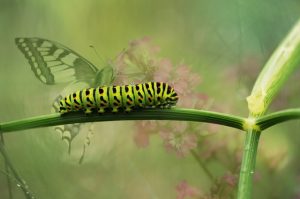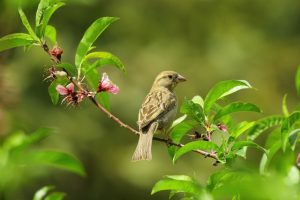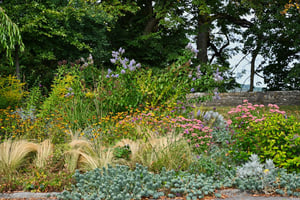Quiet Village Landscaping is happy to feature the following guest-written blog from Cori Westcott, who serves as Habitat Advisor for the St. Louis Audubon Society’s Bring Conservation Home Program. It’s our first in a series featuring Missouri specialist insects and their relationship with their host plants.

With winter time fast approaching, I thought it would be fun to give you a glimpse into the kind of insects that overwinter in just one Missouri native species, the Cup plant. I hope that if you have some in your back garden or native plant space you might consider allowing the stems to remain (either standing or lying down). Those stems are still providing valuable habitat.
When I think of the potential for a bustling natural winter community that may be happening in stems of my Cup plant, Silphium perfoliatum during the winter, Simon’s song cycles through my mind. Wisconsin entomologist Andrew H. Williams collected (in 1996) and identified (1997) over twenty species of insects and spiders overwintering in Silphium perfoliatum stems.
In February, Mr. Williams sent a copy of his table on discovered insect and spider collections from Cup Plant stems in Grant County, Wisconsin to me upon request. He graciously has given me permission to share his findings with you.
Mr. Williams’ findings are listed by taxon. I’ve done a little research to further identify the insects and glean any special behavior to pass along. I’m about to share some intriguing behavior of the Cup Plant’s winter residents in a rapid fire style Mr. Simon used in describing the zoo’s citizens. Cue Simon’s song…
Many of the cup plant stem insects are entomophagous (larva who consume their insect hosts). The movie, Alien, wasn’t original, you know. Braconid wasps are entomophagous, too. Like a chalcidoid, a braconid wasp larva starts as an egg that hatches in the host insect. The host itself intended to overwinter in the Cup plant stem. After emerging from the host, some braconid larvae overwinter in the stem.
Among the specimens Mr. Williams found is the Camptomyia sp., commonly known as a gall midge. Some fungus eating gall midge larvae exhibit a reproduction phenomenon called paedogenesis, “…in which daughter larvae are sometimes produced inside mother larvae, eventually consuming the mother.”(p. 393)[1]
In startled launch, the Mordellistena convicta or Tumbling flower beetle has a tumble caused by his habit of pulling in his legs.
Did you know booklice didn’t eat the book? They ate the mold that ate the book. Lachesilla corona are members of thePsocoptera (meaning gnawed or rubbed wing) order, booklice and plantlice.
Plant bugs of the Miridae family inject enzymes to turn plant tissue into a Slurpee and sip it up through their “beaks”.
Mr. Williams and his colleagues also identified a mite or tick, a cicada, a Silphium borer moth larva, a checkered beetle, a katydid, a featherwing beetle (usually < one mm.) and others. All of these are food sources for birds and other wildlife.
I have great fondness for a plant that defies the common patterns of nature by displaying a square stem. It gets its name from the supply of water it keeps at the base of its joined leaves that serves as a public water source for birds and small mammals. I once bumped a Cup plant and inadvertently drenched my poor husband!
Once the pollinators (in abundance) are finished, the seeds provide much needed food supply to American Goldfinches. Although their brilliant yellow color is waning at this time, it still can be a spectacular sight.
So, once its glory has past, its leaves curled and brown, consider cutting it in foot-long sections and simply leave in on the ground. Its winter residents will find it and still be happy to reside in a horizontal rather than a vertical home. You can also bundle up some, hollow out the ends’ tips on one side and store somewhere the solitary bees can find them for shelter. The plant serves a natural service year round!
To watch pollinators visiting my Silphium perfoliatum, go to: www.youtube.com



